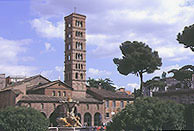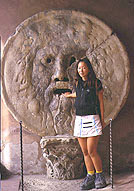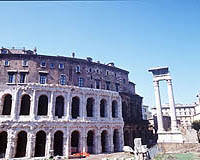Forum Boarium - Ghetto - Tiber Island
St. Maria in Cosmedin and Mouth of Truth
 One of our favorite churches: medieval (6 th Century) and very austere.
One of our favorite churches: medieval (6 th Century) and very austere.
Outside. The bell tower is a fine example of medieval brickwork: seven stories of windows with tiny columns, and plates or porphyry discs stuck into the facade.
Inside. The sparse interior has not been changed in character since the 12 C. All the columns and capitals date from Roman times. In the Dark Ages there was a gallery upstairs so that women could worship away from the men's gaze.
"Cosmedin" means cosmetics, therefore beautiful, in Greek. In the 12C this, then revolutionary, use of broken Roman artifacts to make beautiful floors became the height of fashion. The Cosmati family (did their name come from the church?) had a lucrative business for 200 years. The rood screens of the same work between the altar and public area are particularly fine.

The altar is actually a porphyry bath from Roman times. Much appreciated for its dark purple salami color, porphyry marble mines ran dry in 100 BC. All pieces made since then have been carved out of other sculpted pieces.
On the sacristy wall is an 8C mosaic on gold ground, originally in the old St. Peter's.
Mouth of Truth
Ancient Roman giant marble disc sculpted (about 100 BC) into a human face.
This used to be a drain (how nice for functional drains to be beautiful and funny).
Tradition has it that if you lie while putting your hand into the mouth, it will bite your hand off.
A priest used to hide behind the marble face and whack the wrists of known liars, making them yelp with pain.
A favorite place for mothers with unruly children, and wives with unfaithful husbands.
| St. Maria in Cosmedin History Legend. Aeneas is supposed to have settled here when he arrived from Troy. 495 BC. On these marshlands stood a massive Roman altar and Temple to Hercules. 69-81 AD. Under the Flavian Emperors a columned hall was built for inspectors of the nearby grain, fruit and vegetable market. They checked to make sure that customers did not get cheated. Next door was a stable of pureblood racehorses for the chariot races in Circus Maximus. Also a Temple to Mithras where charioteers could pop in for a prayer before the race. 200. A tiny chapel below ground thought to be part of the foundations of the temple (now the crypt) was built for Christians who risked death worshiping here during harsh regimes. 6C. A small church was erected for Rome's Greek population. 772. Pope Hadrian I enlarged and beautified the building for the flood of refugees from Constantinople escaping the iconoclastic persecutions (when Byzantine church authorities forbade worship of images). 1223. Restored again, including the floor which was redone, perhaps the first Cosmati floor. |
Piazza Bocca della Verità (Map H 8)
Temple of Portunus
(2nd Century BC). A square temple better known as Fortuna Virilis. This building survived by being turned into a church from the 9C until 19C.
Both temples were covered with stucco and painting. They were next to the ancient port of Rome, right opposite the southern tip of the Tiber Island, where the river could periodically be forded.
Cloaca Maxima
(509 BC) King Tarquinius Superbus. The Etruscan genius for draining water by constructing deep channels is epitomized here. The sewage pipes are as tall as a man and can sometimes be visited with special permission.
The whole Forum area, between four of the seven hills, was dried up in this way and became the focal point of the world for 1000 years.
The mouth of this brilliant engineering feat is visible on the east bank just below the Ponte Palatino.
Theater of Marcellus
 Julius Caesar started (11 BC) this construction and Augustus finished it, naming it after his son-in-law and designated heir-apparent, who died too young at age 19 in 23 BC. He was the son of Octavia, Augustus' favorite sister.
Julius Caesar started (11 BC) this construction and Augustus finished it, naming it after his son-in-law and designated heir-apparent, who died too young at age 19 in 23 BC. He was the son of Octavia, Augustus' favorite sister.
Half of the theater disappeared when 3 papal families over the centuries destroyed part of the circle to build a fortified castle and palace.
Today some very lucky people have opulent apartments in this ancient construction.